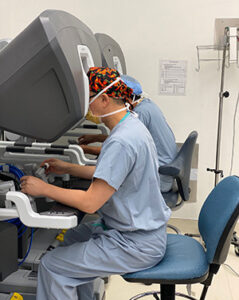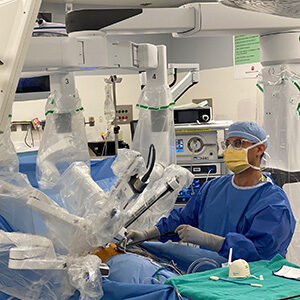
Developments in robotic surgery are enabling procedures in minimally invasive thoracic surgery that previously were not feasible. At Brigham and Women’s Hospital, a team that includes thoracic surgeons and pulmonologists along with experts in vascular surgery, anesthesiology and intensive care has facilitated the increased use of these procedures for many different medical conditions.
“Improvements in the technology allow us to perform operations that historically have been managed with only open surgery,” said M. Blair Marshall, MD, of the Division of Thoracic Surgery. “These advances include better articulation of the instrumentation and increased magnification of the cameras.”
“Noninvasive thoracic procedures tend to be very well tolerated by patients,” added Jon O. Wee MD, section chief for esophageal surgery, director of robotics in thoracic surgery and co-director of minimally invasive thoracic surgery. “They have certainly contributed to shorter hospital stays and better patient outcomes, and in many cases have allowed us to offer surgery to patients who would not be able to tolerate open procedures due to comorbidities.”

The procedures that have benefited from the increased use of robotic surgery include lung surgery after immunotherapy, treatment of tracheobronchomalacia (TBM) and bronchoplasty surgery in patients with airway tumors.
Surgery After Neoadjuvant Immunotherapy
Adding checkpoint inhibitors to the oncology armamentarium has created new opportunities for patients with lung cancer to be cured. But when immunotherapy is used as part of a neoadjuvant treatment strategy, it can present surgical complexities that make more traditional video-assisted thoracoscopic surgery (VATS) inaccessible.
“The addition of immunotherapy creates some of the most technically challenging operations,” Dr. Marshall said. “The robust immune response that occurs as the cancer cells die is unpredictable and can lead to scar tissue that acts almost like a glue between the other tissues.”
“Before the current advances in robotics, these are operations that we would never have tried to treat with minimally invasive approaches,” Dr. Wee said. He explained that the Brigham currently has a number of clinical trials that incorporate immunotherapy into neoadjuvant treatment in patients who predominantly have Stage 3 disease.
Robotic Procedures for Tracheobronchomalacia Cases
Cases of TBM are on the rise, due in large part to increasing obesity rates. This condition, characterized by the collapse of the airway, leads to difficulty breathing, chronic infections and coughing. Historically, patients with TBM have had few options beyond open surgery. Yet due to other health problems, most of them are not good candidates for these open procedures, which can be quite complex.
“These procedures are quite difficult with VATS,” Dr. Marshall said. “Robotics gives us another option.”
“This is a very technical operation that requires a lot of technical maneuvering of the airway,” Dr. Wee said. “With the additional dexterity and individualization that the robot provides, we can now offer many patients the benefits of appropriate surgical care by aligning the airway architecture while diminishing the morbidity associated with a big, open incision.”
Reconstructing Airways With Robotics
Traditionally, surgical treatment for both benign and malignant airway tumors has involved removing much of the lung. Bronchoplasty performed with robotic instrumentation allows surgeons to repair and reconstruct the airway while sparing healthy lung tissue.
“Previously, patients would have been committed to a lung resection with a loss of a large portion of the lung in order to address the airway issue,” Dr. Wee said. “Now we can reconstruct the airway so that only the tumor and the disease is removed, while the lung is left intact and the function is preserved.”
“The real advantage of the robotic technology is not so much the surgical removal of the cancer itself, because a lot of this can be done with VATS,” Dr. Marshall said. “The true advantage comes in the reconstruction, which often requires meticulous fine suturing. This can only be mimicked with the robot.”